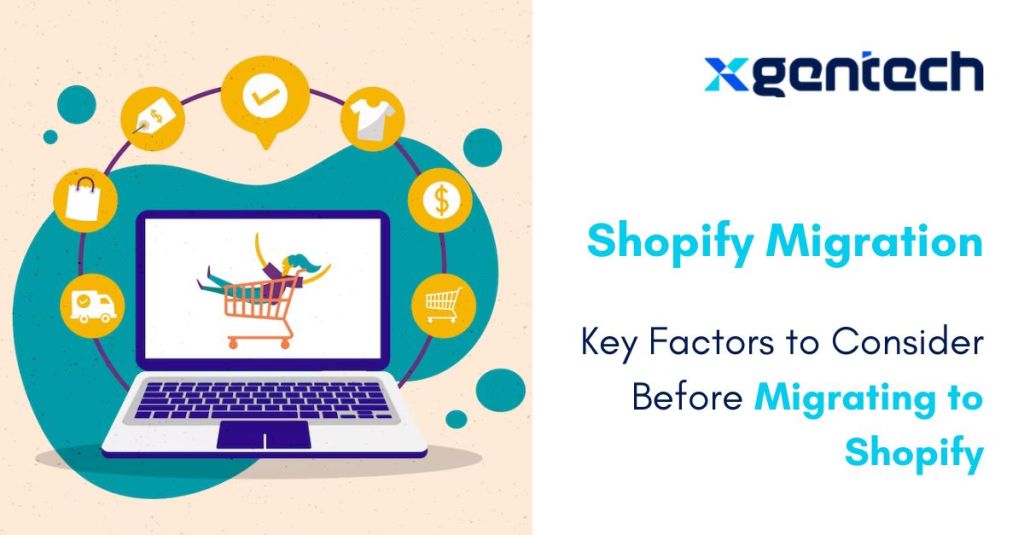In the world of e-commerce, staying ahead of the competition is essential. If you’re looking to level up your online store, migrating to Shopify could be the game-changer you need. Shopify migration refers to the process of transitioning your existing e-commerce store to the Shopify platform.
As your online store grows and evolves, you may find yourself contemplating a platform switch to meet your expanding needs. Shopify, one of the leading e-commerce platforms, offers an array of features and functionalities to help businesses thrive.
However, before embarking on this journey, it’s crucial to consider key factors that will ensure a smooth and successful migration. In this blog post, we will explore what Shopify migration entails and discuss important factors to consider before making the switch.
What is Shopify Migration?
Shopify migration is the process of moving your online store from its current platform to the Shopify platform. This transition involves transferring your store’s data, including products, customers, orders, and other essential information, to the new Shopify environment.
The goal is to seamlessly transition your store’s functionality, design, and features while minimizing any disruptions to your business operations.
Key Factors to Consider Before Migrating to Shopify:
Evaluate Your Current Platform:
Before initiating the migration process, carefully assess your current e-commerce platform. Understand its strengths, weaknesses, and limitations. Identify pain points, such as poor scalability, limited customization options, or inadequate support. This evaluation will help you determine whether migrating to Shopify is the right choice for your business.
Set Clear Goals and Objectives:
Define your goals and objectives for migrating to Shopify. Are you seeking better scalability, enhanced design and customization options, improved performance, or a more user-friendly interface? Clearly outlining your objectives will guide your decision-making throughout the migration process and help you measure the success of your transition.
Plan Your Migration Strategy:
Develop a detailed migration strategy to ensure a smooth and successful transition. Consider factors such as the complexity of your store, the volume of data to be migrated, and the timeline for the migration.
Determine whether you will perform a manual migration, leverage automated migration tools, or hire a professional agency to assist you. A well-thought-out plan will minimize the risk of data loss, downtime, and other potential issues during the migration process.
Data Migration and Integration:
One of the most critical aspects of migrating to Shopify is transferring your store’s data accurately and securely. This includes product information, customer data, order history, and other relevant data points.
Take the time to clean up your data, ensure its integrity, and map it correctly to the corresponding fields in Shopify. Additionally, consider any integrations your current platform has and evaluate if similar integrations or alternatives are available on Shopify.
Theme Selection and Customization:
Choose a Shopify theme that aligns with your brand identity, caters to your target audience, and offers the functionality you require. Shopify provides a vast selection of customizable themes, allowing you to create a visually appealing and engaging storefront.
Consider the design elements, responsiveness, mobile-friendliness, and user experience when selecting a theme. Additionally, plan for customization requirements to ensure your store maintains its unique branding elements.
SEO and URL Structure:
Maintaining search engine visibility and preserving your store’s SEO rankings are vital during the migration process. Ensure that your new Shopify store has proper URL structures and redirects in place to avoid broken links and minimize the impact on search engine rankings. Plan for 301 redirects from your old URLs to the corresponding URLs on Shopify, preserving the traffic and authority your existing pages have accumulated.
Testing and Quality Assurance:
Thoroughly test your new Shopify store before making it live. Conduct extensive quality assurance checks to ensure that all functionalities, including product listings, shopping cart, payment gateways, and third-party integrations, are working correctly.
Test different scenarios, such as placing orders, applying discounts, and processing payments, to ensure a seamless customer experience. By identifying and rectifying any issues beforehand, you can launch your new store confidently.
Post-Migration Support and Training:
Consider the post-migration support and training resources available to you. Shopify offers extensive documentation, tutorials, and a dedicated support team to assist you in navigating the platform.
Familiarize yourself with these resources and ensure that you and your team are equipped with the knowledge needed to manage and optimize your new Shopify store effectively.
Ready to Take your Ecommerce Business to the Next Level?
Shopify migration presents a significant opportunity for e-commerce businesses to unlock the full potential of a robust and scalable platform. By considering the key factors outlined in this guide, you can make an informed decision and lay the groundwork for a successful transition.
Careful planning, data integrity, design customization, SEO preservation, and thorough testing are crucial to ensuring a seamless migration experience. Embrace the possibilities of Shopify and elevate your online store to new heights in the competitive e-commerce landscape.
Discover the power of Shopify migration and learn about the key factors to consider before making the switch to Shopify. Don’t miss out on the opportunity to unlock scalability, customization, and enhanced functionality for your online store. Click here to read our comprehensive guide and start planning your seamless transition to Shopify today!

Leave a comment